A PC chassis does more than just house your components; it’s the foundation of your entire build’s aesthetic, thermal performance, and expandability. A well-chosen case protects valuable parts like the motherboard and graphics card from dust and physical impact while providing the necessary airflow to keep them running cool. For builders aiming for a clean, bright, and modern look, a white PC case is an exceptional choice.
White builds offer a striking canvas that makes RGB lighting pop and gives components a high-contrast, premium appearance. The selection process, however, involves navigating various sizes, features, and cooling philosophies. This guide provides an objective, informational breakdown of ten distinct white PC cases, updated with the latest specifications. It details their features to help you understand their suitability for different types of builds, from compact powerhouses to expansive water-cooled showcases.
For more insights into different chassis options, exploring the various types of PC cases available can provide a broader understanding of the market.
White PC Case Specifications: A Detailed Comparison
This table offers a direct comparison of the key specifications for each of the ten models discussed. Note that some of these models have been succeeded by newer versions, which are mentioned in their respective sections.
| Feature | NZXT H510 | Corsair iCUE 220T RGB | Corsair Crystal 680X RGB | Thermaltake H200 Snow | Fractal Design Focus G | Lian Li PC-O11 Dynamic | Thermaltake Tower 900 | IN WIN A1 Plus | Thermaltake Core P3 TG Pro | IN WIN 101 |
| Case Type | Mid-Tower | Compact Mid-Tower | Mid-Tower (Dual Chamber) | Mid-Tower | Mid-Tower | Mid-Tower (Dual Chamber) | Super Tower | Mini-ITX Tower | Mid-Tower (Open Frame) | Mid-Tower |
| Mobo Support | ATX, M-ATX, M-ITX | ATX, M-ATX, M-ITX | E-ATX, ATX, M-ATX, M-ITX | ATX, M-ATX, M-ITX | ATX, M-ATX, M-ITX | E-ATX, ATX, M-ATX, M-ITX | E-ATX, ATX, M-ATX, M-ITX | Mini-ITX | E-ATX, ATX, M-ATX, M-ITX | ATX, M-ATX, M-ITX |
| Max GPU Length | 360 mm | 300 mm | 330 mm | 320 mm | 380 mm | 420 mm | 400 mm | 320 mm | 450 mm | 421 mm |
| Max CPU Cooler | 165 mm | 160 mm | 180 mm | 180 mm | 165 mm | 155 mm | 260 mm | 166 mm | 180 mm | 160 mm |
| Max PSU Length | 180 mm | 180 mm | 225 mm | 220 mm | 230 mm | 255 mm | 220 mm | 200 mm (SFX-L) | 200 mm | 200 mm |
| Front Radiator | Up to 280mm | Up to 360mm | Up to 280mm | Up to 280mm | Up to 240mm | Up to 360mm (Side) | Up to 2x 560mm | N/A | Up to 420mm (Bracket) | Up to 240mm (Side) |
| Top Radiator | 120mm (Rear) | 240mm | Up to 280mm | Up to 240mm | Up to 240mm | Up to 360mm | Up to 2x 560mm | N/A | Up to 420mm (Bracket) | N/A |
| Included Fans | 2x 120mm | 3x 120mm RGB | 4x 120mm (3 RGB) | 1x 120mm | 2x 120mm LED | 0 | 2x 140mm | 2x 120mm ARGB | 0 | 0 |
| Front I/O | 1x USB 3.2 G1, 1x USB 3.2 G2-C | 2x USB 3.0 | 1x USB 3.1 G2-C, 2x USB 3.0 | 2x USB 3.0 | 1x USB 3.0, 1x USB 2.0 | 1x USB 3.1 G1-C, 2x USB 3.0 | 4x USB 3.0 | 2x USB 3.0 | 1x USB 3.2 G2-C, 2x USB 3.0 | 2x USB 3.0 |
| Dimensions | 428x210x460mm | 395x210x450mm | 423x344x505mm | 416x210x454mm | 464x205x444mm | 446x272x445mm | 752x423x483mm | 357x224x273mm | 535x268x560mm | 425x210x473mm |
| Status | Succeeded | Available | Available | Available | Discontinued | Succeeded | Discontinued | Available | Upgraded | Available |
An In-Depth Look at 10 Notable White PC Cases
1. NZXT H510
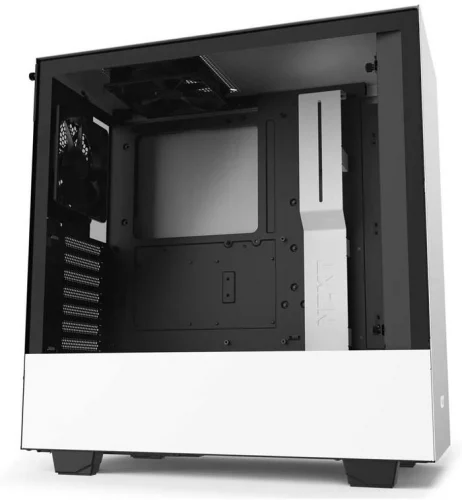
Key Features & Status
- Status: Succeeded by newer models but may still be found at some retailers.
- Materials: Steel, Tempered Glass
- Cable Management: Signature cable routing kit with pre-installed channels and straps.
- Cooling: Designed for negative pressure airflow.
- Included Fans: 2x Aer F120mm Case Version fans.
Analysis
The NZXT H510 became iconic for its minimalist design, clean lines, and user-friendly build process. Its cable management bar elegantly hides cabling, making it simple to achieve a tidy system. However, its original design with a mostly solid front panel limited its airflow potential compared to modern mesh-fronted cases. While functional for many builds, it is not optimized for high-end components that generate significant heat.
Analogy: Think of the NZXT H510 as a classic, well-designed sedan. It’s stylish, reliable, and gets the job done for most daily drivers. However, for high-performance needs, you’d want a vehicle with better air intake and cooling.
Current Alternative: NZXT H5 Flow
For users interested in the NZXT aesthetic but requiring superior cooling, the NZXT H5 Flow is the direct successor. It retains the clean look but features a fully perforated front panel and adds a dedicated fan at the bottom of the case, angled to deliver fresh air directly to the graphics card. This makes it one of the best airflow PC cases in its class.
2. Corsair iCUE 220T RGB Airflow
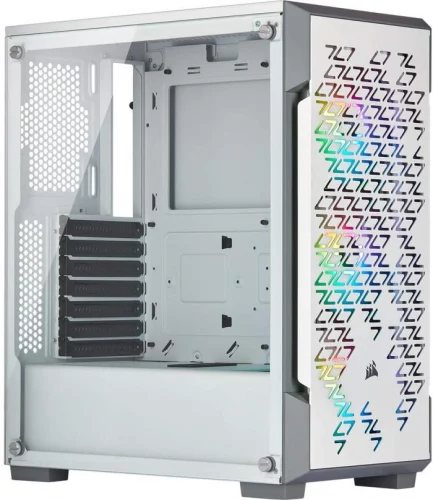
Key Features & Status
- Status: Currently available.
- Lighting: Includes three SP120 RGB PRO fans and an iCUE Lighting Node CORE controller.
- Airflow: High-airflow design with a steel grille front panel.
- Footprint: Compact mid-tower design, smaller than a standard ATX case.
Analysis
The Corsair iCUE 220T RGB Airflow packs strong cooling potential and vibrant, software-controlled lighting into a compact form factor. The included fans and controller offer significant value. Its main constraint is its internal size; the 300mm maximum GPU length and tight PSU shroud can make building with larger components challenging. It’s an excellent choice for users who want a complete RGB and airflow package out of the box for a mid-range build. When setting up its lighting, knowing how to connect RGB fans to a motherboard is a useful skill.
3. CORSAIR Crystal Series 680X RGB
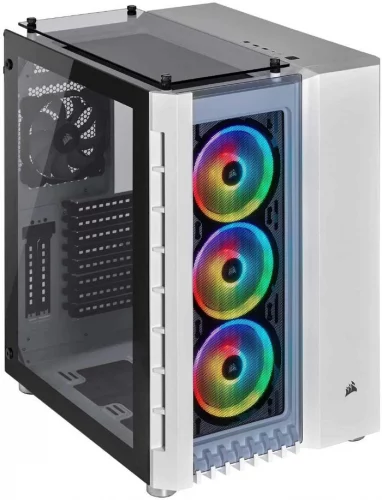
Key Features & Status
- Status: Currently available.
- Design: Dual-chamber layout.
- Visibility: Three tempered glass panels (front, top, side).
- Cooling: Includes three LL120 RGB fans, one SP120 fan, and a Lighting Node PRO.
Analysis
The CORSAIR 680X RGB is a premium case designed to be a showcase. Its dual-chamber layout separates the main heat-producing components (motherboard, CPU, GPU) from the power supply and drives. This not only aids in cooling but also makes cable management exceptionally clean and simple. The inclusion of high-quality LL120 fans and a controller justifies its higher price point. This case is for enthusiasts who want to display their build prominently, particularly those interested in elaborate cases for water cooling. Its wider stance is a key consideration for desk space.
4. Thermaltake H200 TG Snow Edition
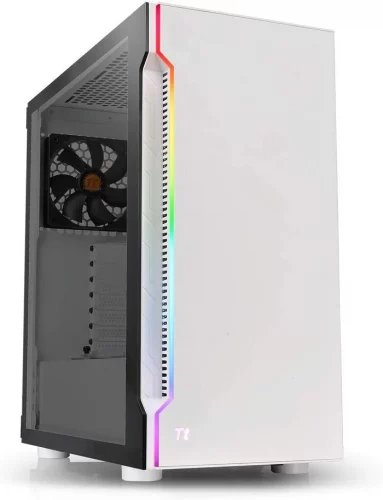
Key Features & Status
- Status: Currently available.
- Aesthetic: Clean front panel with a vertical RGB light strip (19 modes, 7 colors).
- PSU Shroud: Full-length PSU shroud to hide cables.
- Ventilation: Magnetic top fan filter.
Analysis
The Thermaltake H200 Snow is a budget-friendly mid-tower that prioritizes a simple, elegant aesthetic over raw performance. The front panel is mostly solid, with side vents for air intake, which is adequate for entry-level to mid-range systems. Its key selling point is its minimalist look and built-in RGB accent, offering a touch of flair without the complexity of multiple RGB fans. It’s a solid, no-frills choice for builders on a tight budget who value looks.
5. Fractal Design Focus G
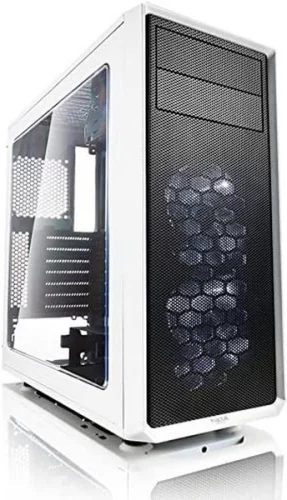
Key Features & Status
- Status: Discontinued.
- Front Panel: Full mesh front for high airflow.
- Drive Bays: Includes two 5.25″ external drive bays, a rarity in modern cases.
- Included Fans: Two white-LED Silent Series LL 120mm fans.
Analysis
The Fractal Design Focus G was a highly regarded budget case in its time, offering excellent airflow potential with its mesh front and two included fans. Its open interior layout was easy to build in, though it lacked modern amenities like a PSU shroud and advanced cable management features. Its inclusion of 5.25″ drive bays makes it a notable option for users who still require an optical drive.
Current Alternative: Fractal Design Pop Air
A modern and superior alternative from Fractal is the Pop Air. It carries the torch of high airflow with a mesh front, adds a PSU shroud, incorporates a more modern design with vibrant color options, and features updated front I/O. It is an excellent successor for those who valued the performance-per-dollar of the Focus G.
6. Lian Li PC-O11 Dynamic
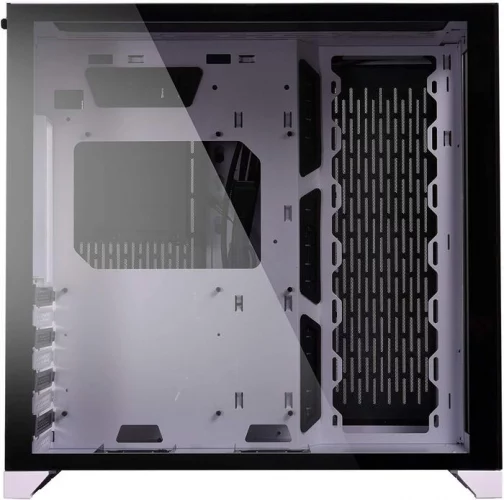
Key Features & Status
- Status: Succeeded by newer, improved models.
- Design: Dual-chamber layout with front and side tempered glass.
- Collaboration: Designed in collaboration with renowned overclocker DER8AUER.
- Cooling Focus: Highly optimized for custom water cooling with multiple radiator mounts.
Analysis
The Lian Li PC-O11 Dynamic revolutionized the PC case market with its dual-chamber design focused on showcasing custom loops. It offered incredible hardware compatibility and cooling versatility in a visually stunning package. By separating the PSU and drives, it provided an unobstructed view of the main components. Its one notable omission was the lack of included fans, as it was assumed builders would use their own high-performance fans for radiators. Understanding the difference between Micro ATX vs Mini ITX vs ATX motherboards is key to utilizing this case’s space effectively.
Current Alternative: Lian Li O11 Dynamic EVO
The O11 Dynamic EVO is the direct evolution of this legendary case. It improves upon the original in nearly every way, offering a reversible layout (for a left-handed orientation), improved airflow, more flexible radiator/fan mounting options, and an optional upright GPU mounting kit. It is the definitive version of this design.
7. Thermaltake Tower 900
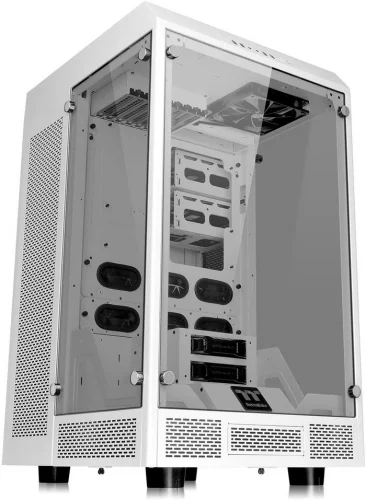
Key Features & Status
- Status: Discontinued.
- Design: Vertical super tower “showcase” chassis.
- Materials: Three 5mm thick tempered glass panels.
- Layout: Unique vertical component mounting.
Analysis
The Thermaltake Tower 900 was an absolute behemoth, designed for one purpose: to house the most extreme and elaborate custom water-cooling builds imaginable. Its vertical design and massive glass panels turned a PC into a museum-quality display piece, effectively eliminating issues like GPU sag. Its sheer size and weight made it impractical for most users, cementing its status as a niche product for dedicated modders and enthusiasts with unlimited space.
Current Alternative: The Tower 500
For those who love the vertical showcase concept but found the 900 too large, Thermaltake’s The Tower 500 is the modern alternative. It provides a similar vertical layout and excellent component visibility for ATX systems but in a much more manageable mid-tower footprint, making the unique design accessible to more builders.
8. IN WIN A1 Plus
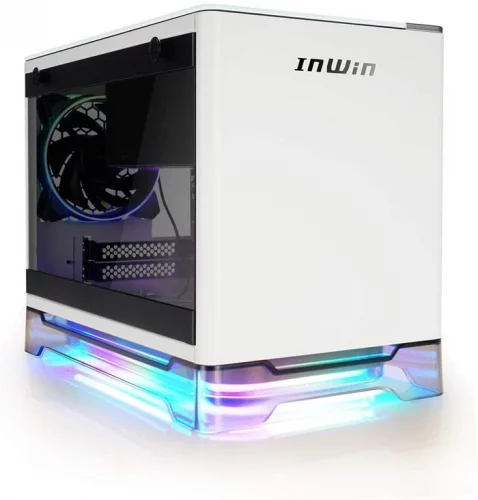
Key Features & Status
- Status: Currently available.
- Form Factor: Mini-ITX.
- Integrated Features: Includes a pre-installed 650W 80+ Gold PSU and a 10W Qi wireless phone charger on the top panel.
- Lighting: Includes two Sirius Loop ASL120 ARGB fans.
Analysis
The IN WIN A1 Plus is a feature-packed small form factor (SFF) case that simplifies the building process. The inclusion of a high-quality, pre-routed power supply removes a major hassle of SFF building. The integrated Qi charger is a unique and genuinely useful feature. Its tinted transparent stand creates a floating effect that is enhanced by underglow from the fans. This case is an outstanding choice for anyone looking to build a powerful yet compact Mini-ITX system with a touch of luxury.
9. Thermaltake Core P3 TG Pro
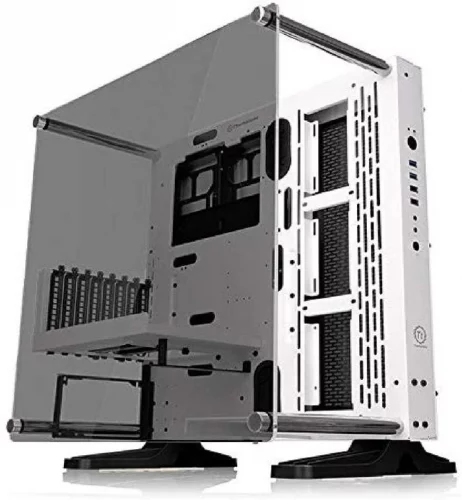
Key Features & Status
- Status: Currently available (This is the upgraded “Pro” version).
- Design: Open-frame ATX.
- Orientation: Can be placed vertically, horizontally, or wall-mounted.
- Improvements: The Pro version adds an extra fan/radiator bracket, modernized I/O with USB-C, and a redesigned base for improved stability.
Analysis
The Thermaltake Core P3 TG Pro is for builders who want to break free from the traditional box. Its open-frame design puts every component on full display, making it a favorite for modders and water-cooling enthusiasts. It offers unparalleled access to components and zero restrictions on airflow. The primary trade-off is exposure to dust, meaning it is best suited for cleaner environments and requires more frequent maintenance. The “Pro” update makes it compatible with larger modern hardware and improves its versatility. Before installing components, it’s wise to learn about the purpose of elements like motherboard standoffs.
10. IN WIN 101
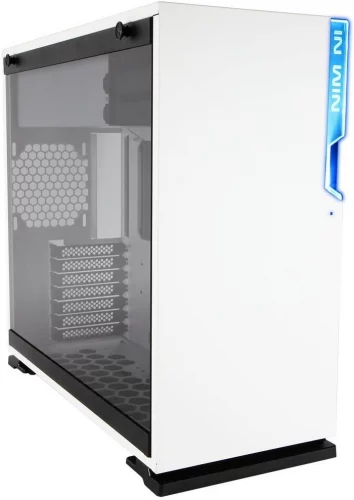
Key Features & Status
- Status: Currently available.
- Layout: Top-mounted PSU chamber.
- Airflow Path: Bottom-to-top/rear airflow.
- Side Panel: Tool-less, quick-release tempered glass side panel.
Analysis
The IN WIN 101 offers a unique take on the mid-tower layout. By placing the power supply at the top, it creates a large, clean chamber below for the motherboard and GPU. This also creates a distinct thermal zone, with PSU heat being exhausted directly out the side. The intended airflow path is unconventional, relying on bottom intake fans (sold separately) to push air upwards across the main components. Its clean front panel, which features a subtly backlit logo, gives it a sleek and understated look.
How to Choose the Right White PC Case: An Expert Guide
Selecting the ideal white PC case requires balancing aesthetics with practical considerations. Here are the critical factors to evaluate.
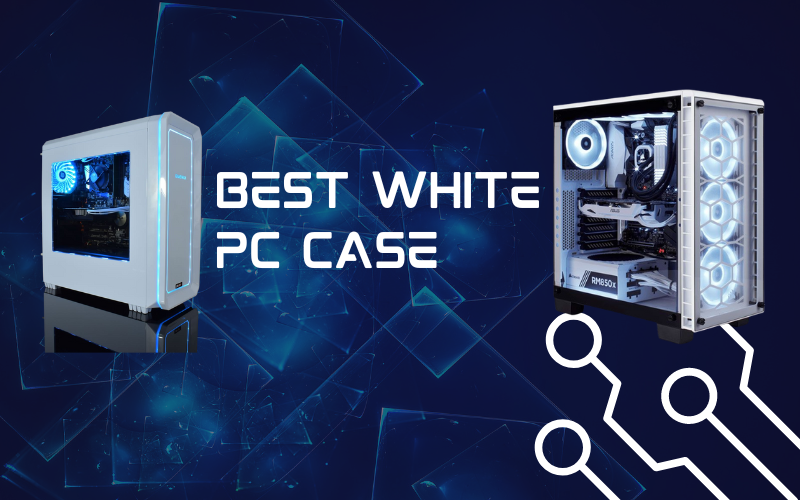
Case Size and Motherboard Compatibility
Cases come in several standard sizes, which correspond to the motherboards they support:
- Full-Tower: Supports all motherboard sizes, including large E-ATX boards. Offers maximum space for components, storage, and elaborate cooling.
- Mid-Tower: The most common size, supporting ATX, Micro-ATX, and Mini-ITX motherboards. It provides a good balance of space and footprint for most gaming and productivity builds.
- SFF (Small Form Factor): Includes Mini-ITX and some Micro-ATX cases. These are designed for compact builds where desk space is a premium. They require more careful component selection due to size constraints.
Always confirm that the case you choose supports your motherboard’s form factor. If you’re unsure of what you have, you can learn what motherboard do I have with a few simple steps.
Cooling Performance: Airflow and Radiator Support
Effective cooling is crucial for maintaining performance and ensuring the longevity of your components.
- Airflow: Cases with mesh or perforated front panels, like the Corsair 220T or Fractal Pop Air, generally offer superior airflow compared to those with solid front panels.
- Water Cooling: If you plan to use an All-in-One (AIO) liquid cooler or build a custom loop, check the case’s radiator support. Specifications will list the maximum radiator size (e.g., 240mm, 280mm, 360mm) supported in different locations (front, top, rear). Cases like the Lian Li O11 Dynamic EVO and Corsair 680X RGB are specifically designed for extensive water cooling.
Component Clearance (GPU, CPU Cooler, PSU)
Physical compatibility is non-negotiable.
- GPU Length: High-end graphics cards can be very long. Check the case’s maximum GPU length specification and compare it against the card you own or plan to buy.
- CPU Cooler Height: Large air coolers can be very tall. Ensure the case’s maximum CPU cooler height clearance is greater than the height of your chosen cooler.
- PSU Length: While most ATX power supplies follow a standard size, high-wattage units can be longer. Check the maximum PSU length, especially in compact cases.
Build Quality and Materials
The materials used affect the case’s durability, weight, and appearance.
- Steel (SECC): The most common material for the main frame, offering strength and durability.
- Aluminum: Often used for exterior panels on premium cases. It is lighter than steel and has a high-end finish.
- Tempered Glass: The standard for side panels, offering a clear view of your components. It is more scratch-resistant than acrylic but can shatter on impact.
Cable Management and Front I/O
- Cable Management: Look for features like a PSU shroud, routing channels, and ample tie-down points behind the motherboard tray. Good cable management improves aesthetics and can also help with airflow.
- Front I/O: Consider the front panel ports you need. Most modern cases include USB 3.0 Type-A ports and audio jacks. Newer or more premium cases also feature a USB Type-C port, which is valuable for connecting modern devices. Knowing about what are USB headers on your motherboard will help you connect these ports correctly.
Frequently Asked Questions (FAQ)
Are white PC cases harder to keep clean?
Externally, white cases can show dirt or scuffs more easily than black cases, but they are generally easy to wipe down. Internally, dust is equally visible in any case with a tempered glass window, regardless of its color. The key to a clean PC is a positive pressure setup (more intake fans than exhaust) and regular dusting.
Do white PC cases turn yellow over time?
This was a common issue with older, low-quality plastics exposed to UV light. Modern high-quality PC cases use durable paints and plastics (like ABS) that are highly resistant to yellowing. A painted steel case, like most models on this list, will not yellow.
What is the difference between a mid-tower, full-tower, and SFF case?
The primary difference is size and motherboard compatibility. Full-towers are the largest, offering maximum space for E-ATX boards and extreme cooling. Mid-towers are the most popular, balancing features and size for standard ATX builds. SFF (Small Form Factor) cases are the smallest, designed for Mini-ITX builds where a compact footprint is the priority.
How important is airflow in a PC case?
Airflow is critically important. Good airflow ensures a steady supply of cool air to your components and exhausts hot air, preventing thermal throttling (where components slow down to avoid overheating). This directly impacts your PC’s performance, especially during intensive tasks like gaming. Keeping an eye on your normal CPU temperature while gaming is a good way to gauge your case’s effectiveness.
Can any graphics card fit into any PC case?
No. You must verify the component clearance. Every case has a “maximum GPU length” specification, and every graphics card has a listed length. Ensure the case’s maximum length is greater than the length of your graphics card, leaving some extra room for easier installation.

Aarav is a custom PC building virtuoso and the head of our PC Builds and System Requirements sections. He specializes in creating clear, step-by-step guides that demystify the process of building a high-performance gaming rig. His meticulous testing ensures our system requirements guides are the most accurate and reliable available.
